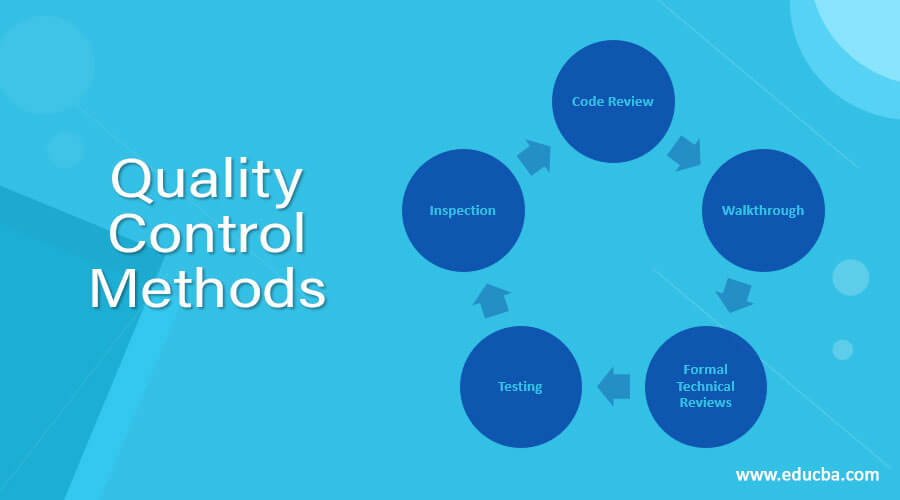Updated April 11, 2023

Introduction to Quality Control Methods
The main task while developing software is to control the quality of the Software product. Quality control deals with correction, product, confidence to the producer, line function and find defects. Process monitoring ensures that appropriate steps decided to carry out the software development process are being followed or not. This is done by comparing the actual steps carried out with those in the documented procedures. The Software engineer monitors the quality control using various methods like walkthrough, formal technical reviews, testing, inspection, and code review.
Quality Control Methods
Let’s discuss the quality control methods in detail.
1. Walkthrough
The walkthrough is an informal code of analysis techniques. In this technique after a module has been coded, it is successfully compiled and all syntax errors are eliminated. In walkthrough, a set of people look at the program code and answer the questions. If the author is unable to answer some questions he or she takes those questions and finds their answers. Some members of the development team are given the code a few days before the walkthrough meeting to read and understand the case. Each member selects some test cases and simulates the execution of the code by hand. The main objective of the walkthrough is to discover the algorithmic and logical errors the code Walkthrough brings multiple perspectives. Discussion should focus on the discovering of errors and not on how to fix the discovered errors.
2. Formal Technical Reviews
The main objectives of formal technical reviews are to uncover the error in function, logic, or implementation, to verify that software under review meets its requirements, to develop software in a uniform manner, to ensure that the software has been represented according to predefined standards, to make the projects more manageable. People involved in review meetings are producer, review leader, and 2 or 3 reviewers.
Formal technical reviews meeting
- Preparation of review meeting: In this, agenda for the meeting and schedule is decided by the review leader. Producer conduct the review material and distribution. Reviewers performs the review in advance.
- Results of review meeting: A review issues list. A simple review summary report is created. Meeting decisions are carried out.
- Accept the work product without further modifications.
- Reject the work product due to errors.
3. Testing
Testing is performed to reveal the presence of bugs in the system as early as possible and make sure they get fixed. Testing is a verification and validation process. Defect testing is Designed to discover the system defect. A successful defect test is one that reveals the presence of defects in the system. Validation testing is used to show that the Software meets its requirements. A successful test is one that shows that requirements have been properly implemented. Acceptance testing enables user to evaluate the applicability and usability of the software in performing their day-to-day job functions. This tests what the user believes the software should perform, as opposed to what the documented requirement state the software should perform. Testing improvement cam base be achieved by evaluating the effectiveness of the testing of the end of each software gest assignment. While this assessment is primary performed by the tester, it should involve the developer, users of the software, and quality assurance professionals if the function exists in the IT organization.
4. Inspection
The inspection involves people examining the source representation with the aim of discovering anomalies and defects. An inspection does not require execution of a system so may be used before implementation. They may be applied to any representation of the system. They have been shown to be an effective technique for discovering program errors. The inspection is conducted only when the author has made sure that the code is ready for inspection. He decides it by performing some primarily desk checking and walkthrough on the code. After passing through these review methods the code is then sent for group inspection.
5. Code Review
The code review for the module is carried out after the module is successfully compiled and all the syntax errors eliminated. Code reviews are an extremely cost-effective strategy for reduction in coding errors in order to produce high-quality code. Code review checklist is as follows
Data faults: Are all program variables initialized before their values are used? Is there any possibility of buffer overflow? If character strings are used, is a delimiter explicitly assigned?
Control faults: For each conditional statement, is the condition correct? In the case of the statement, are all possible cases accounted for? Are compound statements correctly bracketed?
Input/output faults: Are all input variables used? Are all output variables assigned a value before they are output?
Conclusion
Here in this article, we have discussed Quality control and the various methods that have been used by software engineers to control the quality of the Software. Hope you enjoyed the article.
Recommended Articles
This is a guide to Quality Control Methods. Here we discuss the Introduction, List of Quality Control Methods. You may also have a look at the following articles to learn more –
